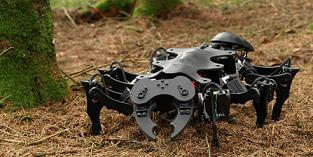
When designing insect robots some engineers stop at the six legs. Norwegian Kåre Halvorsen decided to go ‘full ant’ by including a flexible abdomen and a menacing set of mandibles. His A-Pod robot is a highly capable walker that can also lift objects and even pour a drink! The remote controlled hexapod bot struts itself in a new video that Halvorsen just released. This robot has some amazing dexterity and precision. Check it out below! You don’t want to miss the A-Pod making a delivery (2:24) or playing bartender (3:40). Wait a second! Why are those kids being served a beer?
I’m a big fan of biologically inspired robots (I still can’t get enough of the AirPenguins from Festo) and A-Pod is definitely one of the cooler looking prototypes I’ve seen. While Halvorsen doesn’t seem likely to turn the project into a kit (many of the parts need to be custom made in milling machines), I hope that his ant inspired engineering continues. How awesome, and terrifying, would it be to have an army of these things to do your bidding?
Kåre Halvorsen, who also goes by the name Zenta while online, is a regular on hexapod robot forums. As you can see in the video, A-Pod isn’t his only invention – the Phoenix (2:54) and T-Hex (3:10) robots are also pretty sweet. Those interested in learning more about the specifics of his build (the software he uses, his Basic AtomPro 28 processor, the LiPo battery, etc) should check out his posts. You can find his work (and some amazing high resolution photos) on HexapodRobot, TrossenRobotics, and on his YouTube channel.
The A-Pod has been under construction for more than a year. Halvorsen’s previous video for the robot came back in April of 2009. As you can see in the video below, the bot was already very flexible and could use its mandibles quite well. According to Halvorsen’s commentary on the video (YouTube), the differences in the newest version come from software upgrades and improvements to its walking.
A-Pod’s appearance grabs your attention – how can you ignore a giant black ant with huge mandibles? But that body has more than just cosmetic benefits. Biologically inspired robots take nature’s engineering and modify it for mechanics. This can help us find remarkable innovations such as the Dash robot which runs as quickly, and is nearly as indefatigable, as a cockroach. In some sense A-Pod skirts the edge between biomimetics and mere mechanical impersonation. It uses servos instead of fibrous muscle tissue, but its six-legged gait and realistic torso flexing are very insect-like. I wonder what else A-Pod could accomplish if its mimicry extended into every aspect of its composition as well as its overall form.
[image and video credits: Kåre Halvorsen]
[sources: K. Halvorsen (as Zenta) on YouTube, HexapodRobot, and TrossenRobotics]


